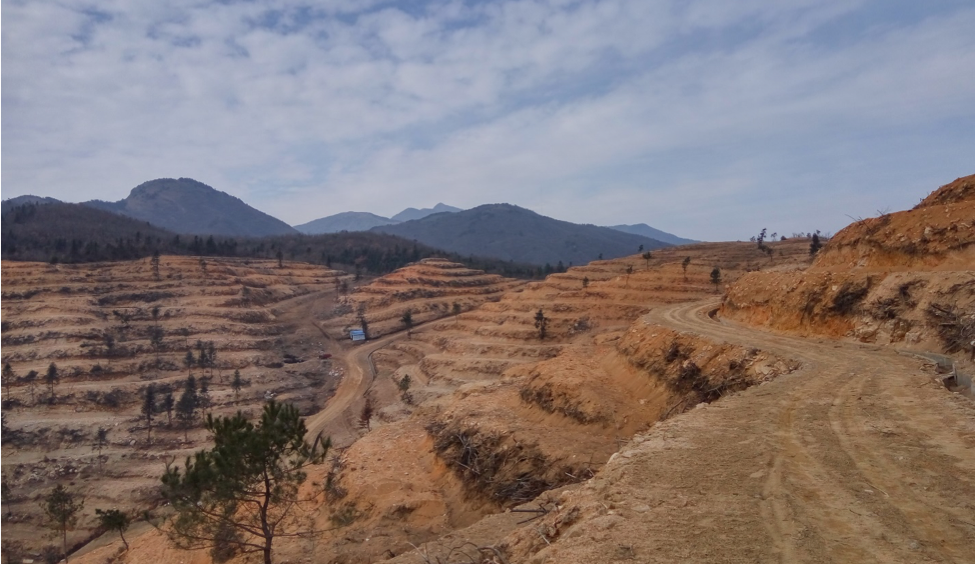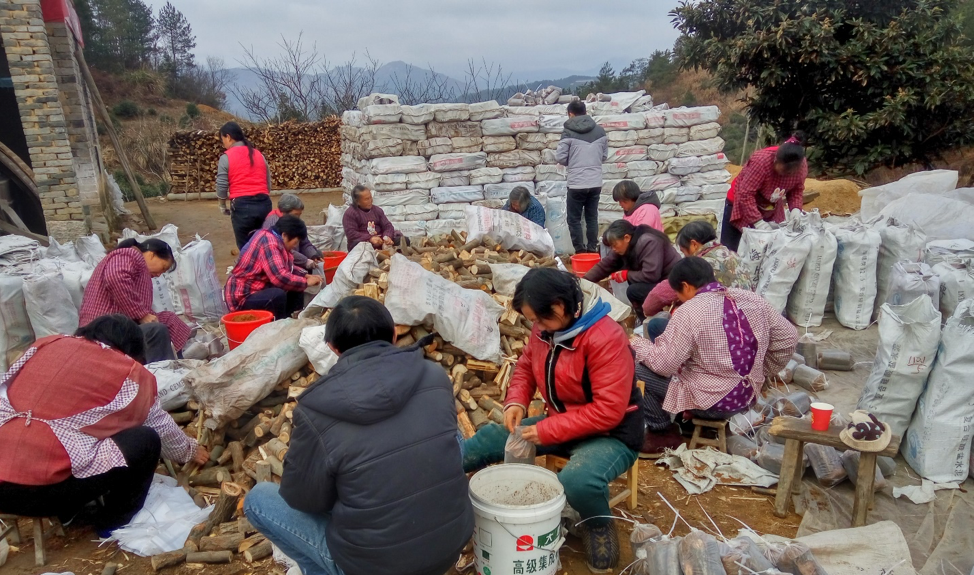Xiaoqian Hu, a Graduate Student Associate at Harvard’s Fairbank Center for Chinese Studies and a S.J.D. Candidate at Harvard Law School, describes how Chinese farmers mitigate conflicts between their livelihoods and the environmental concerns of local governments.
On January 1, 2016, I went to Azalea Village in Mountain County in southern China. Isolated in the mountains, the village had been poor until around the mid-2000s, when people began to grow medicinal fungi. With their newly earned money, villagers had built two-or-three-story houses with white walls, glass windows, and big, open yards.

My host couple, Aunt Qin and Uncle Liu, were farmers in their fifties. When I arrived, Uncle Liu was grafting medicinal fungi at a tea plantation up in the mountains. So, after tea, Aunt Qin and I headed up to the mountains. About halfway, we encountered two middle-aged men dashing down, each carrying two bundles of azalea trees on wooden poles. Aunt Qin greeted them cheerfully: “Freshly dug from the mountains, huh? They’ll be worth two thousand Yuan [about $300].” Smiling, the men replied, “Huh huh. It’s not like we’ve got anything better to do.”
We finally arrived at the plantation, which was owned by Jianguo, the richest town grocer, and two businessmen from outside. Township and village cadres had helped them lease forest land from ten households, including from Aunt Qin and Uncle Liu. As it would be a while before the tea bushes could be planted, Jianguo let his father and Uncle Liu grow medicinal fungi on the land to make some money.

Uncle Liu was spreading fungi between neatly arranged wood sticks, which would provide the ecology for the spores to grow. An unpleasant smell wafted in the wind. Uncle Liu told me it was from bisultap, a pesticide to kill bad bacteria in the fungi.
On the way back, we passed another middle-aged man carrying three azalea trees on a wooden pole. One of the trees was attached to a big, irregularly shaped rock. “The one with the rock is beautiful,” I called out to him.
“Yeah, it weighs a ton. The tree is small, but I dug it for the rock,” the man replied with a proud smile.

That evening Uncle Liu told me that Jianguo rented his forest land for 480 Yuan a year at a rate of 12 Yuan per mu (equivalent to about $75 per year, at a rate of $11 per acre). I commented that the rate was low. He explained that he could do nothing with the forest anyway, because the government prohibited villagers from cutting down trees.
The next morning, while visiting another villager’s house, I ran into the village director, who had come to check if the villager had filed a form to participate in the national agricultural land titling program. The director announced that the GDP of the town’s “azalea industry” in 2015 was twenty to thirty million Yuan.
I asked how he had come up with those numbers.
“There are only a handful of azalea merchants. They come to the town, stay in the hotels, eat in the restaurants, and chat among themselves about how much money they each have spent on buying azaleas. You add up their numbers and there’s the total GDP!”
Seeing my impressed face, he continued, “I say it’s the azalea industry because it is! Villagers make money. Hotels and restaurants make money. Truckers make money. Though it’s illegal, we village cadres pretend not to see.” I wondered whether village cadres also made money.

Growing medicinal fungi, felling trees, and digging azaleas are prevalent, previously legal but recently outlawed activities in Mountain County. Under Chinese property law, rural forests are owned by village collectives. Yet the collectives are obligated to grant 70-year leases on the forests to individual households, which then have the right to use the forest for economic purposes, including planting and felling trees, growing medicinal fungi, and digging plants and flowers. In Mountain County, village-wide leasing took place in the 1980s and the leases were offered orally. Several years ago the county government implemented the national forest land titling program and gave villagers property titles to their leased forest land.
This titling program, as well as the agricultural land titling program that was taking place in Mountain County during my fieldwork, was a Chinese manifestation of the global, largely neo-liberal, discourse on property rights and economic development. In this discourse, rural poverty is diagnosed as an illness of insecure property rights, the cure for which is to give people property titles. Titling is assumed to secure people’s property rights, encouraging them to invest more and make better use of the land, or allowing them to transfer the land to more capable farmers. As the vice director of the Mountain County Forest Department eloquently summarized:
“Rights are secured for the mountains; roots are secured for the trees; hearts are secured for the people. Only when rights are secured will people be motivated to make entrepreneurial uses of forest resources.”
Ironically, the promised benefits of titling were undermined in Mountain County by a different set of laws and policies. China faces immense environmental challenges posed by recent, fast-paced industrialization and urbanization, as well as by age-old problems of deforestation and desertification. Air pollution and food safety concerns worsen in Chinese cities. Perceiving an economic opportunity in these challenges, the Mountain County government adopted an eco-friendly development strategy; relocating or shutting down heavy industry, marketing the county as “unspoiled land” and a “natural oxygen bar,” and promoting eco-tourism, eco-agriculture, and agro-tourism. To preserve forest resources, the county government prohibits villagers from felling trees or digging azaleas, which have been classified as a protected plant. To develop the economy, the government grants the right to fell trees or dig azaleas to selected companies that engage in eco-friendly businesses, such as Jianguo’s Mountain Tea Plantation.
To mitigate the conflict between eco-forestry and villagers’ livelihoods, the government gives villagers 15 Yuan per mu per year as a forest subsidy. “It’s not enough,” the vice director of the county forest department acknowledged, “but it signals a shift in state policy. In the past people paid taxes to the government. Now the government gives money to people.” Aunt Qin and Uncle Liu receive 600 Yuan of forest subsidy a year, which according to Aunt Qin was only enough to buy two weeks of baby formula for their granddaughter.
The fact that villagers are not allowed to cut trees also makes forest land extremely cheap to sublet. As the vice director of Azalea Village commented, “12 Yuan per mu per year is a giveaway.” Titling further facilitates forest land subleases from villagers to companies, as titles contain detailed information about the land and leaseholder and hence greatly reduce the transaction costs of leasing. In a perverse sense, while titling did not make villagers’ property rights more secure, it has secured property rights for eco-business companies.
As the story of Azalea Village shows, villagers in Mountain County defy these legal prohibitions to make money. Urban affluence has created a demand for exotic plants, which in turn has created “smuggling trails” of these plants in Mountain County. Merchants come to the villages to buy azaleas and villagers dig azaleas and sell to them. An industrious villager can make thirty thousand Yuan ($4500) in a good year. Yet azalea trade is pernicious because the flower needs the native soil and climate and will die in a city buyer’s home. Villagers have no serious qualms about it. Money is money. If a tourist company can dig a million azalea trees and make millions of Yuan a year, it is only fair that villagers make some small profit from harvesting the azaleas in their own forests.

Digging and selling azaleas is a small economic affair compared with felling trees and growing medicinal fungi. The increasing urban and overseas demand has kept prices high in recent years. A family can earn as much as 100,000 Yuan per year from growing fungi. For many villagers in Mountain county, growing medicinal fungi is their primary source of income and the only decent livelihood they can make without leaving home. So villagers cut trees in their forest or purchase trees from “smugglers” who have acquired them from villagers in other places.

In Mountain County and in rural China at large, the conflict between eco-forestry and villagers’ livelihoods is framed as a conflict between environmental law and property law, in which environmental law rightly takes precedence. Villagers, by violating environmental law, have become “thieves” and “spoilers” of their own land. Deep down, however, the conflict is political and economic; it is over who receives the highly-restricted privilege to extract forest resources and how much compensation should be given to those who are left out. The Mountain County government chose to reserve the privilege for a few well-resourced fancy players, in part to boost the local economy in a “quick and easy” way, and in part to avoid the much higher administrative costs should the privilege be granted to all or most villagers. To the county government, finding ways for all or most villagers to sustainably extract forest resources and training and monitoring them would require enormous expenses of time, money, personnel, and expertise. Justifiable this choice might have been (which is debatable), the issue of wealth distribution is inescapable. As long as it remains unresolved, villagers will resent the government, disrespect the law, and continue to dig azaleas, chop down trees, and spoil the land with bisultap.
Xiaoqian Hu is a Graduate Student Associate at Harvard’s Fairbank Center for Chinese Studies, and a S.J.D. Candidate at Harvard Law School. Her research studies how Chinese rural citizens negotiate with local governments for access to land, government subsidies, and urbanization wealth.


